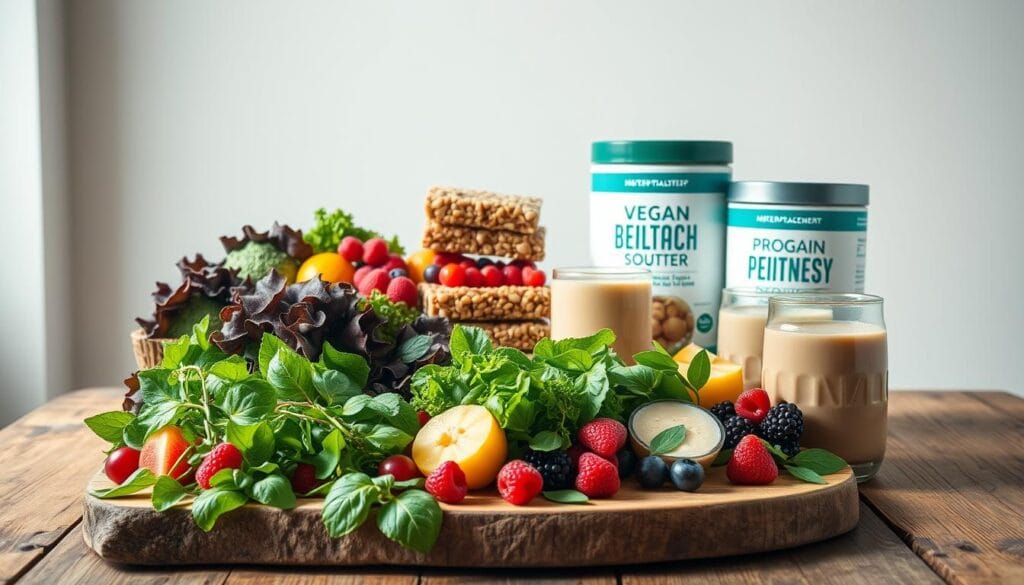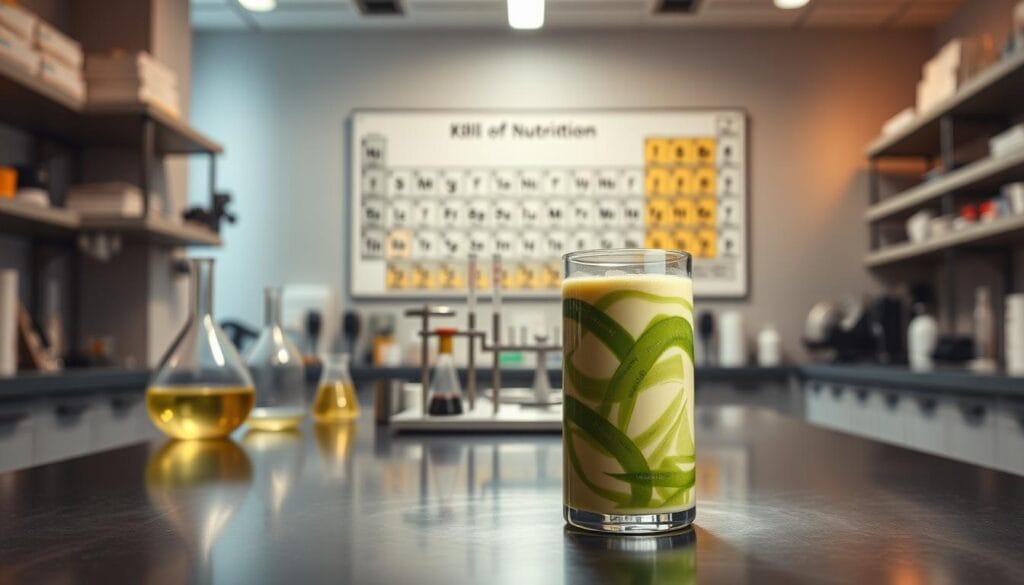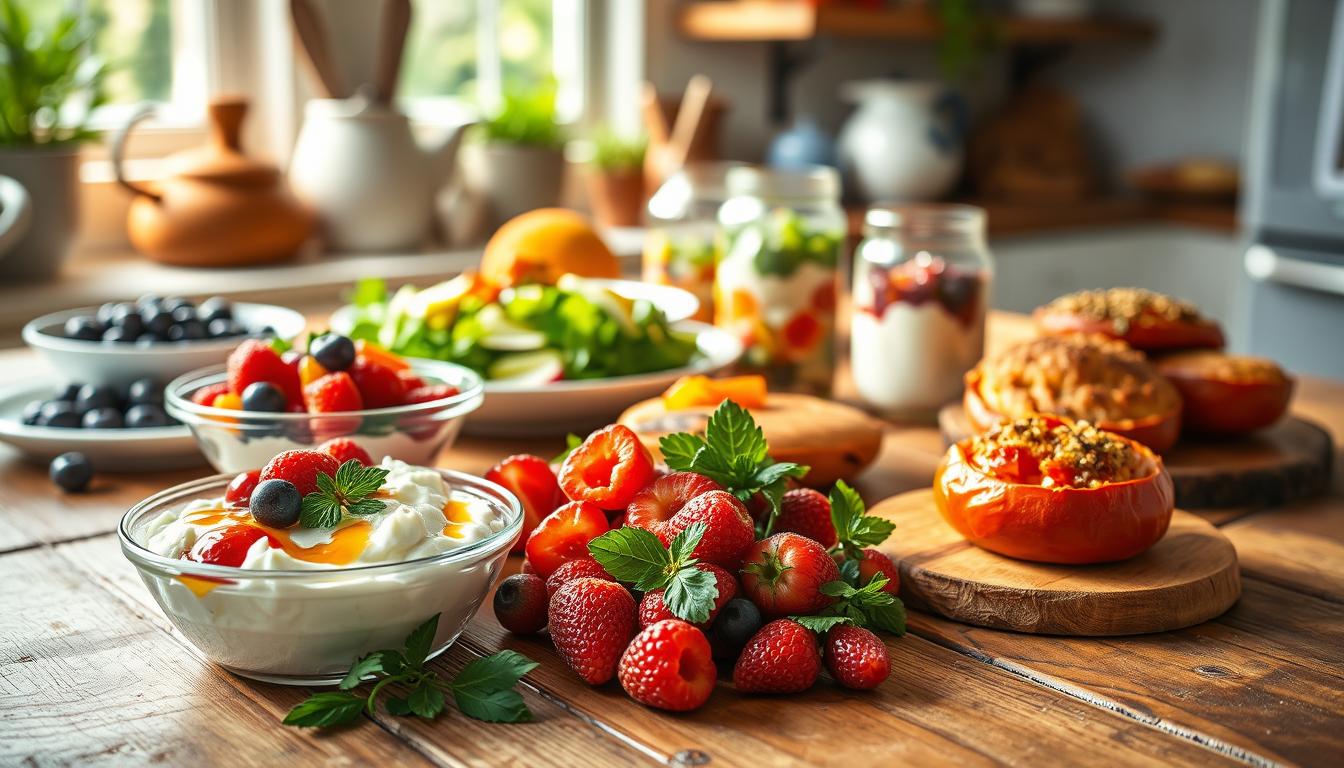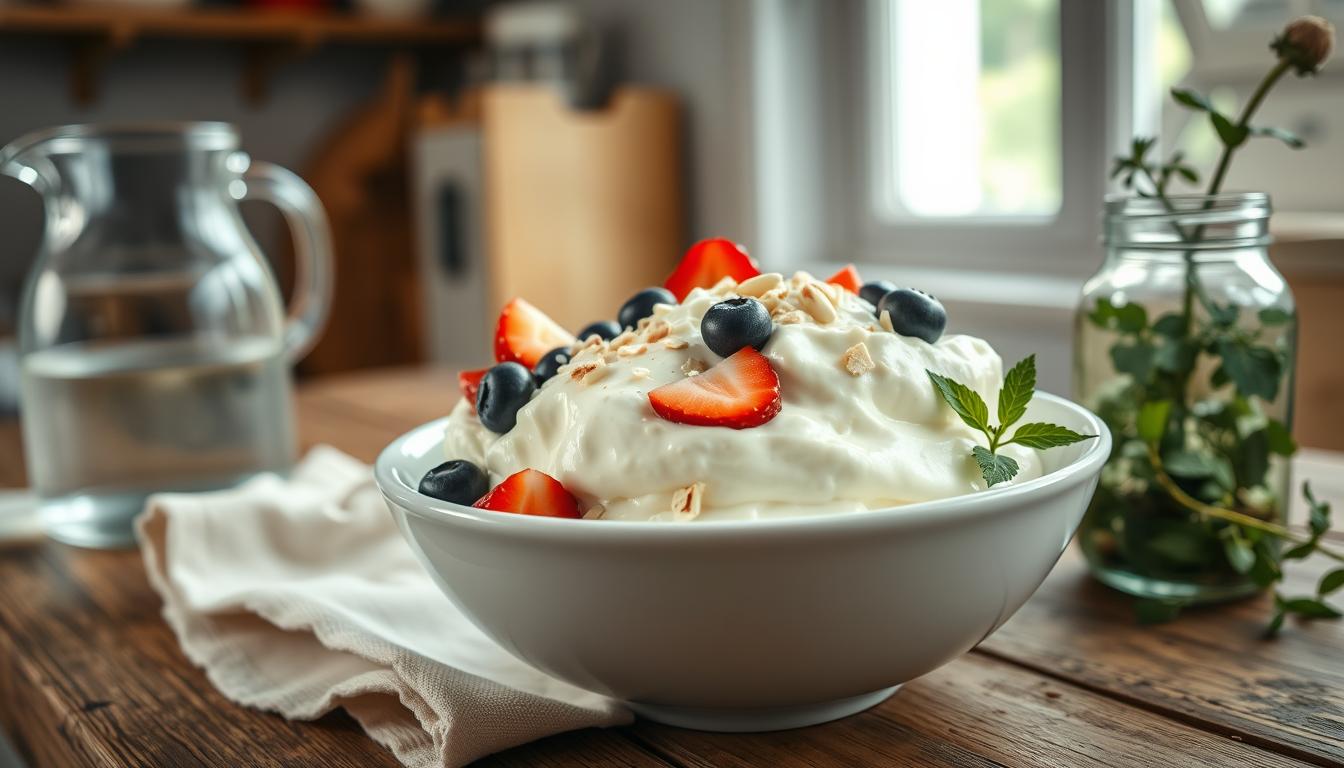Looking for a way to lose weight that’s good for you and the planet? A vegan meal replacement diet might be what you need. These plant-based options are great for managing weight and are both healthy and eco-friendly.
This diet is more than just about losing pounds. It’s about changing how you see food. With plant-based meal replacements, you can help your body lose weight while feeding it the best nutrients.
Studies show that eating plants can really help with weight. These meals are full of fiber and protein, making them a smart choice for losing weight. They offer a new way to diet that’s different from old methods.
Table of Contents
Understanding Plant-Based Meal Replacements for Weight Management
Starting a vegan weight loss plan means choosing the right nutrition. Plant-based meal replacements are a smart choice for those looking to lose weight without dairy.

Meal replacement shakes make it easy to control what you eat. They have 15 to 25 grams of protein per serving. This helps keep your muscles strong while you lose weight.
Benefits of Choosing Vegan Meal Solutions
- Supports calorie deficit management
- Provides balanced nutritional profiles
- Enhances portion control strategies
- Delivers convenient meal alternatives
Key Nutrients in Plant-Based Alternatives
Good vegan meal replacements pack a lot of nutrients. They give 20% to 50% of your daily vitamins and minerals in just one serving. This ensures you get all the nutrients you need.
They also have 3-5 grams of fiber per serving. This helps you feel full and keeps your digestive system healthy. Plus, they have BCAAs to help repair and grow muscles.
How Meal Replacements Support Weight Loss Goals
Studies show that using meal replacements can lead to more weight loss than regular diets. These shakes make it easier to stick to a diet plan. They help you manage your weight in a structured way.
Adding plant-based meal replacements to your diet can lead to lasting weight loss. You’ll also enjoy the benefits of dairy-free nutrition.
The Science Behind Vegan Meal Replacement Diet

Research shows that vegan meals are great for weight management. Studies prove that eating plants can change your body and health for the better.
Vegan shakes help with weight loss in several ways:
- Nutrient-dense protein sources that promote satiety
- Low-calorie profile supporting caloric deficit
- Balanced macronutrient composition
Trials show amazing health changes in those who use vegan meal replacements. The diet’s macronutrient ratio is key:
| Nutrient | Percentage |
|---|---|
| Protein | 25-30% |
| Carbohydrates | 40-45% |
| Fat | 30% |
People on vegan diets tend to be leaner than those who eat meat. Nutritional quality is crucial, with careful planning to get all nutrients.
Studies also show health benefits like better heart health and weight control. Vegan meal replacements can help you reach your nutrition goals.
Essential Components of a Plant-Based Weight Loss Plan
To lose weight on a plant-based diet, you need to know the key nutrients. Cruelty-free meal replacements are a great way to manage weight and stay healthy.
Protein Sources in Vegan Replacements
Finding good protein sources is key for a vegan diet. Vegan proteins have all the amino acids your body needs for muscles and health.
- Pea protein: 21 grams per quarter cup
- Rice protein: 22 grams per quarter cup
- Hemp protein: Rich in omega-3 fatty acids
Fiber and Complex Carbohydrates
Complex carbs give you lasting energy and help control hunger. Foods like whole grains, legumes, and veggies are full of fiber. They keep your digestive system healthy and make you feel full.
| Fiber Source | Fiber Content | Additional Benefits |
|---|---|---|
| Black Beans | 8.5g per 100g | Protein-rich, supports blood sugar regulation |
| Turnip Greens | High calcium content | Supports bone health |
| Collard Greens | Excellent fiber source | Promotes digestive wellness |
Healthy Fats and Micronutrients
Adding healthy fats from nuts, seeds, and avocados is good for your heart. Antioxidant-rich plant sources boost your health and help with weight loss.
The Academy of Nutrition and Dietetics says plant-based proteins meet amino acid needs when you eat enough calories.
Creating a Sustainable Vegan Meal Replacement Schedule
Creating a sustainable vegan meal replacement diet needs careful planning. Success comes from a balanced schedule that meets nutritional needs and supports weight loss.
When planning your plant-based meal strategy, keep these tips in mind:
- Replace 1-2 meals daily with high-quality vegan shakes
- Maintain a consistent daily calorie range between 1,200-1,220 calories
- Ensure balanced macronutrient intake
Your vegan meal replacement diet should follow a structured nutrition plan. Aim for these daily nutritional targets:
| Nutrient | Recommended Amount |
|---|---|
| Carbohydrates | 100-125 grams |
| Protein | 50 grams |
| Fiber | 30 grams |
| Fat | 60-70 grams |
To get the most from your vegan meal replacement diet, strategically plan your shake consumption. Replace breakfast or lunch with a nutrient-rich plant-based shake. Then, add whole food meals for extra nutrients and variety.
Consistency is crucial in your weight loss journey. Slowly add plant-based meal alternatives to your routine. This lets your body adjust and keeps your energy up all day.
Popular Plant-Based Protein Sources for Meal Replacements
To make protein-packed vegan meals, it’s key to know the best plant-based proteins. Vegan shakes for weight management use special protein mixes for full nutrition.
Pea Protein Benefits
Pea protein is a top choice for plant-based proteins. It has about 25 grams of protein per 100g. It’s great for those looking for vegan meals with lots of protein. The benefits include:
- High digestibility
- Rich in branched-chain amino acids
- Supports muscle recovery
- Easily absorbed by the body
Brown Rice and Hemp Protein Combinations
Mixing brown rice and hemp proteins gives you a complete amino acid profile. Hemp seeds have 30g of protein per 100g. Brown rice adds more amino acids.
Complete Amino Acid Profiles
Getting a complete protein source is vital in plant-based diets. Mixing different proteins ensures your body gets all essential amino acids. Aim for 10% to 35% of daily calories from protein.
Pro tip: Aim for 15-25 grams of protein per meal replacement shake to support your weight management goals.
Choosing the right plant-based proteins is key to a good nutritional journey. It helps you make tasty and effective vegan meal replacements.
Transitioning to a Vegan Meal Replacement Diet
Starting a vegan weight loss plan needs careful planning. You’ll learn how to add plant-based meal replacements to your daily life.
Here are some steps to begin:
- Gradually replace animal protein with plant-based alternatives
- Listen to your body’s nutritional needs
- Create a balanced meal replacement schedule
- Monitor your protein and nutrient intake
Only 1% of Americans eat strictly vegan, making your choice unique. The 2023 Wakefield Research found 42% of Americans are interested in plant-based foods. This shows a growing interest in vegan diets.
Your vegan diet should be well-rounded. The American College of Lifestyle Medicine says plant-based diets can help with weight and health. Aim for a 500-1,000 calorie deficit each day for safe weight loss.
Make sure you get enough amino acids like lysine, methionine, and tryptophan. Vegans might find it hard to get these. Include different protein sources like:
- Pea protein
- Brown rice protein
- Hemp protein
- Legume-based protein blends
Your vegan diet should be tailored to you and last long term. Talk to a nutritionist to make sure you’re getting all the nutrients you need for your vegan weight loss plan.
Maximizing Weight Loss Results with Plant-Based Shakes
Vegan shakes are a smart way to reach your fitness goals. They are easy to use and full of nutrients. This makes them great for losing weight.
Knowing when to use them can really help. Let’s look at how to get the most out of plant-based meal replacements.
Optimal Timing for Meal Replacement Consumption
Timing is everything for losing weight. Here are the best times to have vegan shakes:
- After working out to recover
- Between meals to stop hunger
- Instead of breakfast
Portion Control and Caloric Balance
It’s important to control how much you eat. Here’s what you should aim for:
| Meal Replacement Type | Calorie Range | Protein Content |
|---|---|---|
| Typical Protein Shake | 200-300 calories | 18-25 grams |
| Daily Meal Plan | 1200-1500 calories | 60-75 grams |
Keep track of your calories to stay in a calorie deficit. Replace one to two meals with vegan shakes. Add whole foods to keep your diet balanced.
Pro tip: Mix your vegan shakes with light exercise and whole foods. This will help you lose weight and stay healthy in the long run.
Common Challenges and Solutions in Vegan Meal Replacement Plans
Starting a vegan weight loss plan with cruelty-free meal replacements can be tough. Knowing the challenges helps you find ways to succeed in your diet change.
One big worry is getting enough nutrients. But, with the right planning, you can avoid nutritional gaps. This is done by choosing the right supplements and finding different protein sources.
- Protein diversity in cruelty-free meal replacements
- Managing hunger and energy levels
- Preventing taste fatigue
- Maintaining social eating flexibility
“Success in a vegan meal replacement diet comes from informed choices and adaptive strategies.”
More people are choosing plant-based nutrition. By 2024, the meal replacement shake market is expected to hit USD 5,189.6 million. This shows how popular alternative diets are becoming.
| Challenge | Solution |
|---|---|
| Nutrient Deficiency | Comprehensive supplement regimen |
| Protein Intake | Varied plant-based protein sources |
| Motivation | Regular progress tracking |
Your vegan weight loss plan should include a variety of cruelty-free meal replacements. This ensures you get all the nutrients you need for lasting weight management success.
Incorporating Whole Foods with Meal Replacements
Adding whole foods to your plant-based diet is key for good nutrition and lasting weight loss. Meal replacements are convenient, but mixing them with whole foods makes your diet balanced. This ensures you get all the nutrients you need.
Mixing meal replacements with whole foods boosts your nutrition and helps you reach your health goals. Here are some tips to follow:
Balanced Nutrition Strategies
- Choose diverse plant-based ingredients to go with meal replacements
- Add fresh fruits and vegetables for extra nutrients
- Include whole grains to boost dietary fiber
- Use nuts and seeds for healthy fats and more protein
Meal Planning Tips
- Replace one to two meals a day with vegan meal replacements
- Plan meals with whole foods around your vegan meals
- Use meal replacements as a base for nutrition
- Try different whole foods to keep your diet interesting
“Nutrition is about balance, not perfection.” – Anonymous Nutritionist
Studies show meal replacements can help with weight management by controlling calories. By adding whole foods, you get a full nutrition plan. This supports your weight loss efforts.
Conclusion
Your vegan meal replacement diet is more than just for losing weight. It’s a big change in how you eat and live. With only 3% of Americans being vegan, you’re part of a growing health movement. This movement cares about your health and the planet.
Choosing plant-based meals has many benefits. They help reduce your carbon footprint by 30-90% compared to meat. By picking meal replacements like LyfeFuel or Vega One, you support your health and the planet.
Success in a vegan diet needs careful planning and balanced nutrition. Talk to health experts to make your diet fit your body’s needs. Your goal is to make lasting changes for better health and to help the environment.
Every choice you make, like having a shake or a meal, helps you and the planet. Be proud of your decision. It can change your life and inspire others to live healthier and more sustainably.


